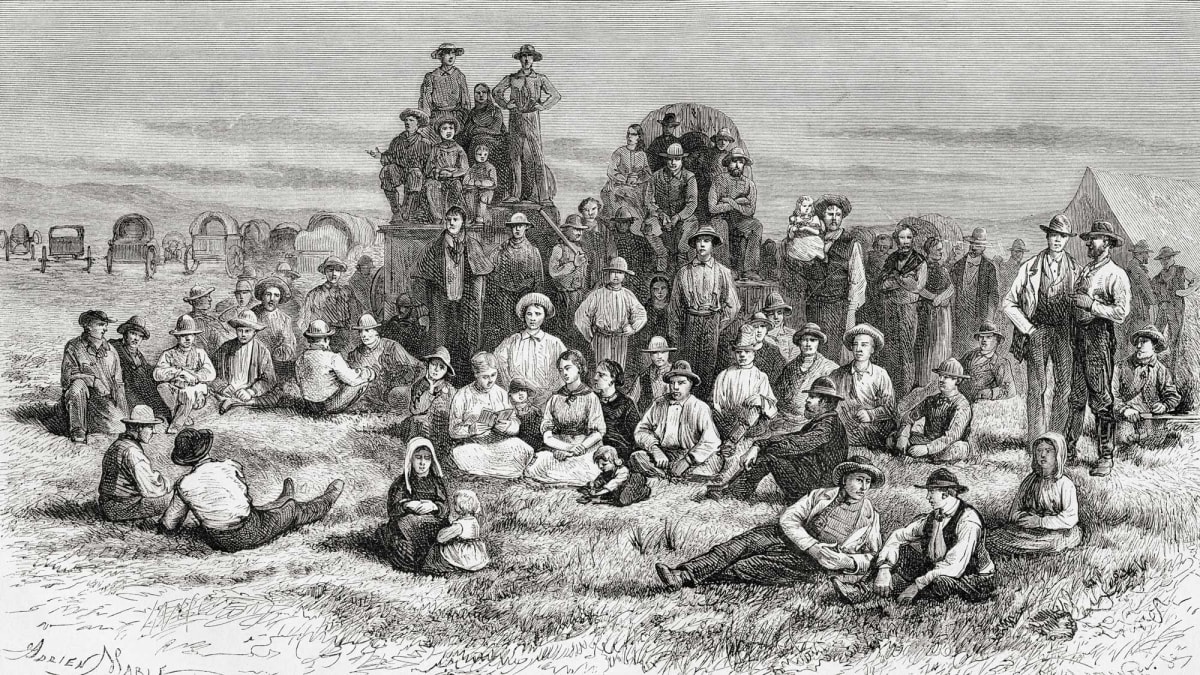
While accompanying the first company of immigrants who crossed the ocean to the outfitting place, David Henry Cannon secured passage on a steamboat on the Missouri River. Setting out from St. Joseph, the steamboat stopped at Nebraska City. J. J. Creighton came on board the steamboat at that place. He made the acquaintance of Cannon and expressed his desire to hire from 75 to 80 men to set telegraph poles from the Missouri River to Salt Lake City. Cannon told him that when they reached Omaha, he should make an appointment with Jacob Gates, the superintendent of Mormon emigration that year. On about 25 May, Gates and Cannon went to Omaha and arranged to furnish Creighton with 75 men. The men received half of their salaries in advance. They used this to help pay for the emigration of their families. The contract stipulated that the remainder of their salaries would be paid to them in Salt Lake City no later than 15 November.
Edward Creighton, a staunch Irish Catholic, was an experienced builder of telegraph lines. He first started hauling telegraph poles. He superintended the building of a telegraph line from Ohio to New Orleans. He also helped create telegraph lines between Dayton and Cincinnati, Toledo and Cleveland, and Toledo and Chicago. After moving to Omaha, he built a telegraph line from there to St. Joseph, and another line to Fort Smith, Arkansas. In 1861 he was the general superintendent of construction for the Pacific Telegraph line to Salt Lake City. Associated with him were his cousin, James Creighton, and his brother, John A. Creighton. The latter joined the company at Fort Laramie after freighting goods to Denver.
James Ward and John Vincent, Mormon immigrants from England, were among those who joined Creighton’s construction crew. The telegraph construction crew totaled 400 men, each armed with a navy revolver and a rifle. They had 500 animals—mules and oxen—with over 100 wagons. They left Omaha for Fort Kearny on 17 June, the western terminus of the telegraph line. Edward Creighton left part of his crew here. Their job was to extend the line westward. With the remaining men, Creighton pressed on to Julesburg, Colorado Territory. Here, on 2 July, he personally dug a hole and set the first pole. Two days later, the men at Fort Kearny started their work. Some twelve miles out, Indians set fire to a few poles, but a telegrapher quickly notified the fort and troops soon arrived. By early September, the crew that started from Fort Kearny had reached Julesburg.
Each member of the construction crew had a specific assignment. There were surveyors who marked the route and loggers who sought out timber and cut poles or trimmed away tree branches that might interfere with the telegraph line. As they neared Utah, Creighton got many of his poles from John W. Young, a son of Brigham Young. There were teamsters who drove wagons loaded with poles, dropping them one by one at seventy-yard intervals. Other workers dug five-foot deep holes in which pole setters placed the telegraph poles. Other wagons carried large reels of wire. Wire stringers climbed the poles, installed insulators, and hung the wire. Other wagons carried provisions, insulators, chemicals, and batteries. Herdsmen managed the livestock and guarded the herds at night. Others in the company were hunters. Edwin Parker, a Mormon emigrant from Preston-Candover, Hampshire, England, dug holes until he reached Fort Bridger, then he became a stringer. Between Fort Laramie and Fort Bridger, the line followed up the Sweetwater River and over South Pass, but progress was slow. They generally progressed from three to eight miles a day. Each evening a telegrapher established an Outer Station so he could receive and send messages. Pony Express riders carried dispatches back and forth between these transitory makeshift stations. By 11 September, the Outer Station was some ninety miles west of Fort Laramie. Within two miles of Fort Bridger, they ran out of wire. Creighton, who constantly patrolled up and down the line in a coach, got more wire from another crew that was building eastward from Salt Lake. These two lines united on 17 October and the Mormon crew followed the completed line on to Salt Lake.
Formed in Fort Kearney, Kearney, Nebraska, United States
Edward A Creighton Appointed as Company Captain
Start Date Details
End Date Details
Ended Circa 1861
Ended in Salt Lake City, Salt Lake, Utah, United States
Date Details
Occurred Circa 1861
